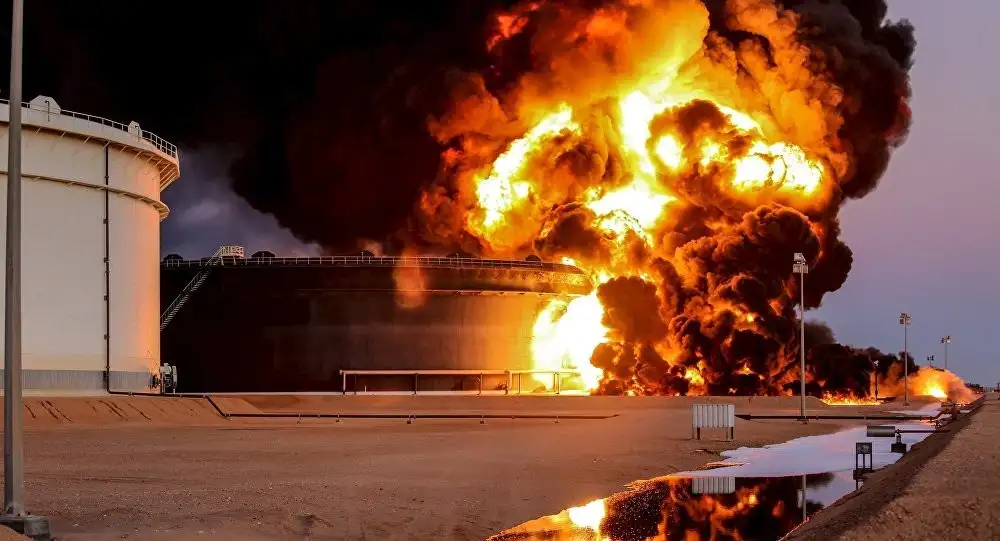Fire protection is an inseparable part of industrial systems. Fire protection of pressurized or atmospheric storage tanks is also one of the important issues that is important during the design and commissioning in order to reduce injuries and damages caused by combustion. Because fires and explosions in storage tanks can cause irreparable damage to people’s lives and the environment.
Fire protection of storage tanks
Fire protection of storage tanks is important in both spherical and cylindrical tanks. Unlike pressurized spherical tanks, atmospheric storage tanks hold liquids under low or no pressure. Most liquids or gases that emit liquids are volatile, highly flammable, or even explosive. Among the dangerous liquids stored in this type of tanks, we can mention liquid fuel such as car oil, gasoline, alcohol, methanol, ethanol, propanol, butanol, biodiesel, diesel, gasoline, airplane fuel, paraffin, and other chemicals.
Most liquids can leak, seep or even vaporize and release flammable vapors through even the smallest flaw or opening, so special care must be taken to ensure safe operation of tanks containing such hazardous liquids. Not surprisingly, depending on the nature of the fluids contained, many environmental regulations apply to the design and operation of atmospheric storage tanks. Many of these regulations apply naturally to the prevention of flammability of liquids and gases.
These storage tanks can be open or closed at the top. The roof of cylindrical tanks can be floating or fixed. Floating roofs are structures that rise and fall depending on the fluid level inside the tank. In many industries, including oil refineries, floating ceilings are a prerequisite for safety as well as a preventive measure against atmospheric pollution because they keep combustible vapor above the liquid level to a minimum.
Consequences after the accident
The potential for fire or explosion in the storage of highly flammable liquids in enclosed spaces is obvious, even to those not charged with ensuring their safety. In identifying ways to reduce storage tank fire protection, the number of accidents, life threatening and storage tank fire protection are considered, but considering that storage tanks are important capital assets and often central elements in critical operations, the financial consequences and interruption There is also significant that the loss of such facilities indicates.
Business continuity is therefore a critical consideration, as are the significant environmental consequences a fire can have, both in terms of the fire itself and the efforts required to extinguish it.
The importance of full or empty tanks
While the fire hazard presented by full tanks is fairly obvious to everyone, perhaps more surprisingly to the uninitiated, these same tanks can cause problems even when empty. If they have been used to store volatile products such as the previously mentioned fuels and are left untreated, the tank atmosphere is likely to fill with explosive hydrocarbon fume residues. These will be highly flammable and, if ignited, can explode with catastrophic consequences and cause catastrophic damage.
Causes of fire
One of the main causes of fires and accidents involving atmospheric storage tanks is worn or damaged lip seals on floating roofs. Tank design can vary from manufacturer to manufacturer and from site to site depending on local requirements. Regardless of tank size and design, one of the obvious fundamental concerns for any detection or activation of a fire suppression system is the use of electrical equipment in hazardous areas with flammable liquids and atmospheres. These types of hazards require the implementation of intrinsic safety techniques, i.e. the use of systems using certified barriers or isolators.
The technique behind intrinsic safety is to ensure that the electrical and thermal energy present in the instrumentation of the implemented system is always low enough that ignition cannot occur. Intrinsic safety barriers are able to protect the safe operation of electrical equipment such as detection and activation systems in hazardous areas, even areas classified as Zone 0 (ie areas where an explosive mixture is present continuously or for a long time).
Storage tank fires are a challenge for both tank operators and firefighters. The value of the material increases the risk of injury in a tank fire. Modern technology has made fire protection options readily available to tank designers and operators. Proper equipment selection and proper design can make the difference between disaster and safe operations. Also, the distance and layout of the tank, its design, materials and construction of closed walls affect the choice of equipment. For this reason, international standards have been developed to reduce injuries and damages caused by fire.
Fire fighting system standards
The National Fire Protection Association (NFPA) decides the fire protection guidelines for tanks in the United States. These include foam delivery plan specifications, rates and spacing. The contents of the tank determine the application rate of the foam, which varies between 4 liters per square meter per minute and 12 liters per square meter per minute.
Concentrated foam
Fire fighting foam is an integral part of fire protection systems of tanks. The concentration of the foam must match the contents of the tank and the various application systems. Fluorine protein foams are best for hydrocarbon hazards and alcohol resistant aqueous film forming foams are best for hazards miscible with water or polar solvents.
Foam induction
The foam induction fit system plays the main role in the tank protection system. Simply put, the correct amounts of water and foam are essential for a perfect mix.
The foam delivery device determines the amount of foam solution. For fixed foam solution demand, fixed linear inductors are the best choice. For variable foam solution demand, you can choose between two: Balanced Pressure Fit Balanced Valve on Foam Floor and Balanced Pressure Fit Foam to Bag Tank.
Foam skids work well with water motor, diesel or electric foam pumps. Single or multiple skids can feed foam systems. Therefore, they are not always readily available.
Cooling water
Radiant heat is a major hazard for storage tanks. Cooling water can minimize its effect. A mushroom nozzle can cool the roof and other nozzles can cool the walls of the tank. Oscillating screens are great for even more surface cooling.
band protection
Retaining walls are usually overlooked because the tanks attract attention. But if the runway walls are damaged, the casualties will not decrease.
A fire in this area can be caused by a leaking valve or tank or a broken pipe. These can also cause major accidents. A medium expansion foam system can protect walls from fire and vapor suppression.
Edge sealing system
Sometimes it is difficult to detect a fire in the edge sealing system, especially when the floating roof is at its lowest level. Early detection is essential to reduce casualties. The design should be wind resistant. Strategic fixed monitors are also useful to complement the edge seal system.
In this article, we discussed the fire protection of storage tanks. Hope this content is useful. Petrosazeh Beinolmelal Aram Co provides raw materials, designs, manufactures and installs all types of fixed oil and gas equipment such as spherical tanks and cylindrical tanks, towers, condensers, heat exchangers, etc. Contact us for expert advice and implementation of engineering structures.


